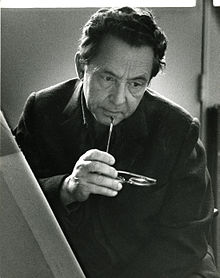Hans Hartung
| Hans Hartung | |
|---|---|

Hans Hartung, photo by Paolo Monti, 1960 (Fondo Paolo Monti, BEIC)
|
|
| Born |
September 21, 1904 Leipzig, German Empire |
| Died | December 7, 1989 Antibes, France |
| Nationality | German-French |
| Movement | Tachism, Lyrical Abstraction |
| Awards | Venice Biennale Grand Prix |
Hans Hartung (21 September 1904 – 7 December 1989) was a German-French painter, known for his gestural abstract style. He was also a decorated World War II veteran of the French Foreign Legion.
Hartung was born in Leipzig, Germany into an artistic family. He developed an early appreciation of Rembrandt, German painters such as Lovis Corinth, and the Expressionists Oskar Kokoschka and Emil Nolde. In 1924 he enrolled in Leipzig University, where he studied philosophy and art history. He subsequently studied at the Fine Arts academy of Dresden, where he copied the paintings of the masters. The modern French and Spanish works he saw in 1926 at the Internationale Kunstausstellung in Dresden were a revelation to him, and he decided that he would leave his native country to prevent succumbing to provincialism. Consequently, after a bicycle trip through Italy, he moved to Paris.
In Paris, Hartung had little contact with other artists, and copied the works of old and modern masters. He visited the south of France, where the landscape inspired him to a close study of the works of Cézanne, and he developed a great interest in principles of harmony and proportion such as the golden section. In 1928 he visited Munich where he studied painting technique with Max Doerner. In 1929 he married the artist Anna-Eva Bergman and established himself in the French towns of Leucate, and then in the Spanish Balearic Islands, eventually settling in Minorca. He exhibited for the first time in 1931 in Dresden.
The death of his father in 1932 severed Hartung's last bonds with Germany. He was rejected from Nazi Germany on account of being a 'degenerate', because his painting style was associated with Cubism – an art movement incompatible with Nazi Germany's ideals. In 1935 when he attempted to sell paintings while visiting Berlin, the police tried to arrest him. He was able to flee the country with the help of his friend Christian Zervos.
...
Wikipedia
